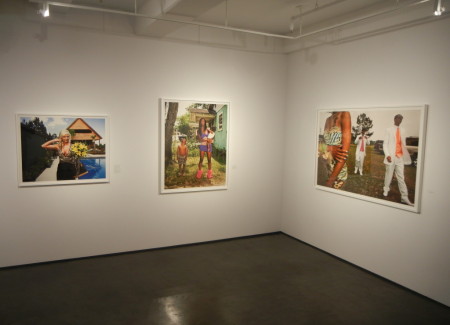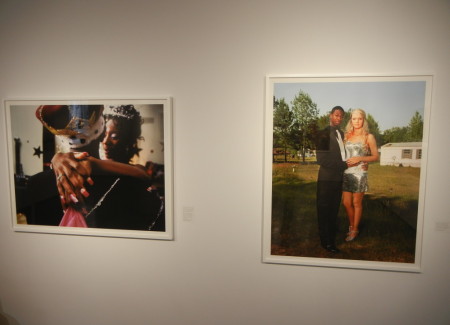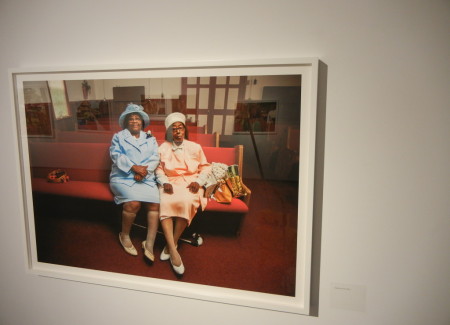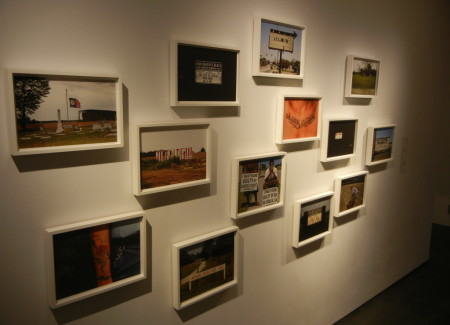JTF (just the facts): A total of 34 color photographs (32 single images and 1 diptych), framed in white and unmatted, and hung against white walls in the two room gallery space and the side hallway. All of the works are archival pigment ink prints, made between 2002 and 2014. The prints are shown in a variety of sizes – 11×14 (edition of 8+1AP), 20×24 (edition of 8+1AP), 30×40 (edition of 5+1AP), and 40×50 (edition of 3+1AP). The show also includes 1 video (2015, 3:09 minutes, edition of 3, shown in a darkened side room) and 1 vitrine containing a hard written class essay, a 2002 yearbook, a spread from the 2009 New York Times Magazine, and 3 small color photographs. A monograph of this body of work was published in 2015 by Damiani (here), and a documentary film was released by HBO in 2015 (here). The project website can be found here. (Installation shots below.)
Comments/Context: Part of what makes a long term photography project rich and robust is its ability to be read and interpreted on multiple levels – if we can find multiple points of entry into the work, it’s usually a good sign that the subject has enough complexity to sustain our interest over an extended period of time. Gillian Laub’s twelve-year Southern Rites project traces the lives of the inhabitants of Mount Vernon, Georgia, and fundamentally tries to do the impossible – to visually document something invisible, in this case, an evolving set of historically complicated attitudes toward race. Given that she can’t directly capture the overbearing elephant in the room with her camera, her pictures are like a set of found clues and forensic evidence, where remnants of the injustices of the old South and manifestations of new thinking mingle side by side, often in a silently uneasy equilibrium where a hint of body language or a facial expression is all we need to determine where thinly buried opinions really lie.
The story begins with Laub’s visit to Montgomery County High School in 2002, where she documented the schools’ segregated homecoming celebrations. A pair of images from this initial trip set up the framework for the entire project – a staged group portrait of the tiaraed homecoming court, where two sets of queens and ladies in sparkly dresses (one white and one black) have been intermingled in one smiling ensemble, and an intimate portrait of a mixed couple (Julie and Bubba), their finger-entwined embrace evidence of real tenderness and acceptance. Seen together, the two pictures tell a story of the clash of old rules and new attitudes (at least on the part of the younger generation), and the need for a continued conversation between the two.
In subsequent years, Laub returned to Mount Vernon to capture the school’s separate proms, befriending many of the students and families and making portraits of the young men and women on their big night. Her pictures ran in a 2009 photoessay in the New York Times Magazine and immediately generated a firestorm of attention. Few could believe that this kind of blatant segregation could still exist in 21st century America.
While having a party at the end of the school year can’t be claimed as an American invention, prom has evolved into a meaningfully symbolic ritual in the life of an American teenager. In one dazzling night, we combine a beginning and an end – the celebration of hard earned academic accomplishments, a moving on to new schools and new challenges, a final goodbye to teachers and friends, maybe even a good party and a little romance. It’s become a public moment of transition into adulthood, decked out in fancy suits and slinky dresses, and plenty of notable American photographers (particularly Mary Ellen Mark) have found subtleties in its quiet drama.
Laub’s pictures document the swirl of emotions caught up in such a night – excitement, pride, awkwardness, anxiety, nervousness, even blank-eyed fear – but then add the extra layer of ages-old racial tension and distrust to the mix. Kids who had grown up together were separated for the night into white and black proms, many unclear on exactly why they couldn’t celebrate together. There is a distinct sense of the older generation not in synch with the younger, at least in terms of how they are thinking about the issues (or non-issues).
While these portraits exhibit a few differences of fashion choices (from cocktail dresses to ball gowns), hairstyles, and apparent affluence (a fancy swimming pool versus a wooden shack as backdrops), in general, the pictures look like many you might find from all across this country, albeit with meaningfully less smiling faces. Ultimately, the school system caved in and integrated the proms into one single event, and Laub’s images from prom parties in the following years feature more mixed couples, and as we might expect, they don’t look any more comfortable slow dancing than anyone else, especially since more people were nervously watching.
Intermingled with Laub’s prom pictures are more atmospheric details from around town, where cotton and onion fields still stretch for miles and grandmas still go to church in their Sunday best. Signs of faith are everywhere, often with an undercurrent of simmering menace – road signs claiming “Jesus died for you” quickly morph into “Don’t let Satan trick you into hell” or “The key to heaven was hung on a nail”. Luckily, one church pairs a message of “God loves you so much” with a reminder of available onion burgers as a further enticement. And yet, the Confederate flag flies over a cemetery and is proudly displayed on a young woman’s tube top, and young black offenders wear shaming signs on street corners describing their crimes, so clearly some polarized attitudes remain firmly entrenched. Like Gordon Parks and David Goldblatt before her, albeit in different times and places, Laub is trying to document the insidiousness of entrenched racial biases by pointing out their indirect symbols hiding in plain sight.
Laub’s extended portrait takes a surprisingly disheartening turn at the end, when one of her original subjects, a young African-American man, is unexpectedly shot and killed by an older white resident. A short video depicting the 911 call grimly resets all the usual stereotypes in place – the black boy in “baggy britches” found in his house at night, the unthinking instinct to shoot the intruder when he ran (when indeed he was a guest of his daughter), and then the man slumped in shocked, mute resignation at his mistake. It begs the questions of how far we have come and how much further we need to go to find sustainable justice and respectful living for all.
This is the kind of photographic project where the whole is inevitably stronger than the sum of its parts; seeing the images together and in sequence (in the gallery, book, or documentary film) will certainly be more powerful than any one stand alone photograph could possibly hope to be, and the backstory captions fill out many of the human details and relationships largely invisible in the pictures. The reason the project succeeds is that the prom story at its center is both universal and specific, providing viewers of all kinds with both an easy point of entry and identification, and then a smart segue into broader and more complicated ideas about the ongoing race dialogue in contemporary America. That the emotional roller coaster of this symbolic event ranges so widely from hope to despair is a stark reminder that this conversation is far from finished.
Collector’s POV: The works in this show are priced based on size, ranging from $2500 to $9000, with intermediate stops at $3500 and $6500. Laub’s work has little secondary market history, so gallery retail likely remains the best option for those collectors interested in following up.















